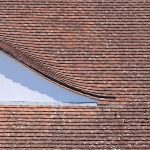
Ice dams are a common problem in colder climates, especially during the winter months. They occur when snow on the roof melts and then refreezes at the edge of the roof, creating a barrier that prevents water from draining properly. This can lead to water backing up under the shingles and causing damage to the roof, walls, and ceilings of a home. There are several factors that can contribute to the formation of ice dams, including inadequate insulation and ventilation in the attic, fluctuating temperatures, and poor roof design. When warm air from the living space rises into the attic, it can cause the snow on the roof to melt. If the attic is not properly insulated or ventilated, this melted snow can refreeze at the edge of the roof, creating an ice dam. Fluctuating temperatures can also contribute to the formation of ice dams, as rapid temperature changes can cause snow to melt and refreeze repeatedly. Additionally, roofs with a shallow pitch or complex design are more prone to ice dams, as they do not allow for proper drainage of melted snow.
Another common cause of ice dams is heat loss from the home. When warm air escapes from the living space into the attic, it can cause the snow on the roof to melt. This heat loss can be caused by a variety of factors, including inadequate insulation, air leaks, and improperly sealed ductwork. In some cases, ice dams can also be caused by a combination of these factors. For example, a poorly insulated attic with inadequate ventilation and a shallow-pitched roof may be more prone to ice dams than a well-insulated attic with proper ventilation and a steeper roof pitch. Understanding the causes of ice dams is crucial for preventing and addressing this issue effectively.
Assessing the Risks and Damages
Ice dams can cause a range of problems for homeowners, from minor water damage to more serious structural issues. When water backs up under the shingles due to an ice dam, it can seep into the attic and walls, causing damage to insulation, drywall, and wood framing. This can lead to mold growth, rot, and deterioration of the structural integrity of the home. In addition to interior damage, ice dams can also cause damage to the exterior of the home, including gutters, soffits, and fascia. The weight of the ice dam itself can also put stress on the roof structure, potentially leading to sagging or even collapse in extreme cases.
In addition to physical damage, ice dams can also pose safety risks for homeowners. As water backs up under the shingles, it can leak into light fixtures and electrical outlets, posing a risk of electrical shock or fire. Additionally, as ice dams melt and refreeze, they can create icicles that pose a hazard to people walking near the home. Assessing the risks and damages associated with ice dams is important for determining the best course of action for removal and prevention.
Safe and Effective Removal Techniques
When it comes to removing ice dams, it’s important to do so safely and effectively to minimize further damage to the home. One common method for removing ice dams is using a roof rake to pull snow off the roof before it has a chance to melt and refreeze. This can help prevent the formation of ice dams in the first place. However, if an ice dam has already formed, it may be necessary to use a more direct approach to remove it. One effective method for removing ice dams is using a steamer to melt the ice. This involves applying steam directly to the ice dam, which can help break it up and allow water to drain off the roof.
Another method for removing ice dams is using calcium chloride or another ice melt product. This involves placing the ice melt in a sock or pantyhose and laying it across the ice dam. As the ice melt dissolves, it can create a channel for water to drain off the roof. However, it’s important to use caution when using ice melt products, as they can be corrosive and may damage roofing materials or gutters if not used properly. It’s also important to avoid using sharp tools or excessive force when removing ice dams, as this can cause damage to the roof and increase the risk of injury.
Preventative Measures for Future Ice Dams
Preventing ice dams from forming in the first place is often more effective than trying to remove them after they have already formed. One key preventative measure is ensuring that the attic is properly insulated and ventilated. This helps maintain a consistent temperature on the roof surface, reducing the likelihood of snow melting and refreezing. Additionally, sealing air leaks in the attic and around ductwork can help prevent heat loss and reduce the risk of ice dams forming.
Another preventative measure is ensuring that gutters and downspouts are clear of debris and properly maintained. Clogged gutters can prevent water from draining off the roof, increasing the risk of ice dams forming. Installing gutter guards or heat cables can also help prevent ice dams by promoting proper drainage of water from the roof.
In some cases, it may be necessary to make modifications to the roof itself to prevent ice dams. This can include adding additional insulation or installing a membrane underlayment to prevent water from seeping into the attic. Additionally, installing a metal drip edge along the eaves of the roof can help prevent snow from accumulating and forming ice dams.
Hiring Professional Help
While some homeowners may be able to remove ice dams themselves using DIY methods, in many cases it’s best to hire a professional for safe and effective removal. A professional contractor will have the knowledge and experience to assess the situation and determine the best course of action for removing ice dams without causing further damage to the home. Additionally, professionals will have access to specialized equipment and tools that may not be readily available to homeowners.
When hiring a professional for ice dam removal, it’s important to choose a reputable contractor with experience in dealing with this issue. Look for contractors who are licensed and insured, and who have positive reviews from previous customers. It’s also important to get multiple quotes from different contractors to ensure you’re getting a fair price for the work.
Tools and Equipment for DIY Removal
For homeowners who choose to remove ice dams themselves, there are several tools and equipment options available for DIY removal. One common tool for removing snow from the roof is a roof rake, which allows homeowners to pull snow off the roof from ground level. This can help prevent snow from melting and refreezing at the edge of the roof, reducing the risk of ice dams forming.
Another option for DIY removal is using a steamer to melt the ice dam directly. Steamers are available for purchase or rental at many home improvement stores and can be an effective way to break up an existing ice dam. Additionally, homeowners can use calcium chloride or another ice melt product in a sock or pantyhose to create a channel for water to drain off the roof.
It’s important for homeowners to use caution when using tools and equipment for DIY removal of ice dams. Avoid using sharp tools or excessive force when removing ice dams, as this can cause damage to the roof and increase the risk of injury.
Environmental Considerations and Regulations
When removing ice dams, it’s important to consider environmental regulations and best practices for disposal of melted snow and ice melt products. In some areas, there may be regulations regarding where melted snow can be discharged or restrictions on certain types of ice melt products due to their environmental impact.
Additionally, homeowners should be mindful of potential environmental hazards associated with removing ice dams. For example, if an ice dam contains debris or contaminants such as bird droppings or mold spores, it’s important to take precautions when removing it to prevent exposure.
When using ice melt products for DIY removal of ice dams, it’s important to choose products that are safe for use around plants and pets. Avoid using products that contain harmful chemicals or that may leach into groundwater or surface water.
In conclusion, understanding the causes of ice dams is crucial for preventing and addressing this issue effectively. Assessing the risks and damages associated with ice dams is important for determining the best course of action for removal and prevention. Safe and effective removal techniques include using a roof rake, steamer, or ice melt products with caution. Preventative measures for future ice dams include proper insulation and ventilation in the attic, maintaining gutters and downspouts, and making modifications to the roof if necessary. Hiring professional help may be necessary in some cases, but homeowners can also use tools and equipment for DIY removal with caution. Environmental considerations and regulations should be taken into account when removing ice dams to minimize impact on the environment. By taking these factors into consideration, homeowners can effectively address and prevent ice dams while minimizing damage to their homes and surrounding environment.



